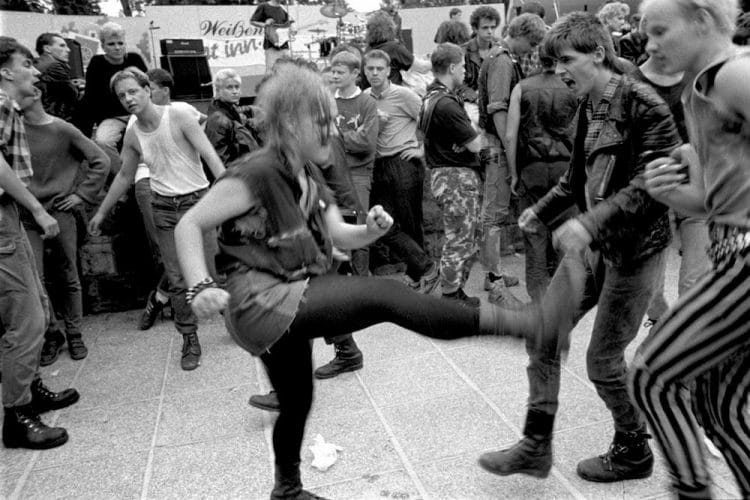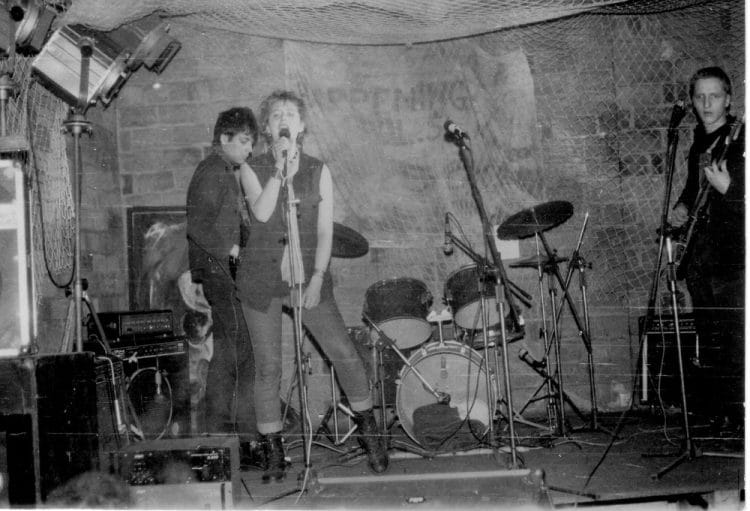via Dazed Digital
In 1977, a 15-year-old German girl called Britta Bergmann kickstarted a movement that ultimately helped bring down the Berlin Wall.
Bergmann, who lived in East Berlin, discovered the Sex Pistols in a teen magazine acquired by her older half-sister from West Berlin, and became entranced by their spiky image and rabble-rousing sound. She began mirroring the trailblazing band’s aesthetic, chopping off her hair and adorning her clothes with rips and epaulets of safety pins. She soon decided that punk was the thing for her, becoming acquainted with the politically-minded zeal of British groups like X-Ray Spex and relaying the rebellious messages she heard on western radio back to her peers. Earning herself the nickname of ‘Major’, a small scene grew up around her. In less than a year, the Stasi (East Germany’s secret police agency) had opened a file on Bergmann and she was considered an enemy of the state.
A stream of homegrown DIY punk bands formed in the years that followed, giving a voice to the repressed and creating a vehicle for resistance. This under-the-radar movement thrived against the odds; there were no legal venues to perform in, artists couldn’t get into studios to record, and materials like photocopiers were nonexistent. Bands staged illegal concerts in churches – one of the safest spaces in East Germany at the time – and would record these concerts and circulate the tapes. East Germany’s underground punk network quickly became a dangerous source of political dissidence and a magnet for Stasi surveillance; even stepping out in punk garb was viewed as an oppositional statement.
“One reason that punk became such a threat was that it quickly became something uniquely Eastern”, explains journalist Tim Mohr, the author of a recent book chronicling the movement, Burning Down the Haus: Punk Rock, Revolution, and the Fall of the Berlin Wall. “When they started putting these bands together, they were doing it all in German and it was all about their own lives. British punks were singing about their futures and socio-economic conditions, while the problem in East Germany was almost the direct opposite; they had too much future. There was no unemployment in East Germany, and their lives were scripted by the party.”
Key bands like Wutanfall (which translates to ‘Tantrum’), Planlos (‘Aimless’) and Namenlos (‘Nameless’) became symbols of anti-authoritarianism. In their lyrics, they criticised the Stasi and sung about uniquely East German issues, like trying to regain control over the big decisions in their own lives. Jana Schlosser, singer of the band Namenlos, was sent to Stasi jail for two years after comparing the Stasi to Hilter’s SS. Punks served longer jail sentences than any activist group in the 70s and 80s, and they were also blacklisted from jobs, having to take work as gravediggers or hospital waste operators.
Punk musicians defied the state to make art and were banned from public spaces in 1981. “These are the people who really fought the dictatorship and paid a price,” says Mohr. “The punks were detained and interrogated and kicked out of school and conscripted into the army. They paid with their bodies to bring down the dictatorship.” Major later spent a year in Stasi prison.
East German punks also laid the blueprint for future subcultures and social movements like squatting. “The idea was to live your life the way you want it, dress the way you like, listen to the music you like, and not to be patronised or locked-in behind walls and barbed wire,” recalls photographer Christiane Eisler, who immortalised the 80s punk scene through her images. “The state’s position was that there was no such thing as punk in the GDR and that punk had nothing to do with a socialist state. But there were punks and not just a few of them. So I wanted to contradict the state and show that the punk movement existed in the GDR.”
The Stasi would try and recruit minors in the punk scene to inform on their friends. Juergen Gutjahr’s band Wutanfall were key figures in the movement and came under immediate attack from the Stasi. Several members ended up in jail for various stints and Gutjahr recalls a harrowing “near-death experience” at the hands of the Stasi aged 17. “They tied me up, put a bag over my head and beat me in the forest.” Two of his bandmates later turned out to be Stasi informants. “It was such a great breach of trust,” he says. “Even now, the damage still hasn’t been repaired.”
The idea for the book, which Mohr says has been 25 to 30 years in the making, came to him while he was living in Berlin in the early 90s and working as a DJ. Many of Berlin’s clubs at the time were operated by former East German punks, and Mohr came into contact with figures from the punk world, including the vocalist from Planlos, Michael ‘Pankow’ Boehlke. “Planos were pretty much the most important of the first-generation East Berlin bands,” explains Mohr. During the dictatorship, Boehlke kept a stash of lyric scraps and photographs in a false drawer bottom, and this set Mohr off down the rabbit hole of discovery.
While many activist groups during the period took a reformist approach to their fight, the punks wanted to fuck the system and destroy it. “This was just a very powerful message – especially when trying to recruit people to the fight,” offers Mohr. “The biggest mystery in a society like that is what happens to you if you do run afoul of the secret police, and the punks carried out that experiment. For someone from West Germany, it was almost impossible to understand what they were bringing upon themselves, but these kids came back out of jail and went right back out there to fight. So basically that showed to other opposition-led people that it was possible to resist and survive. And that was a game-changing revelation.”
Check out the full feature here!











































